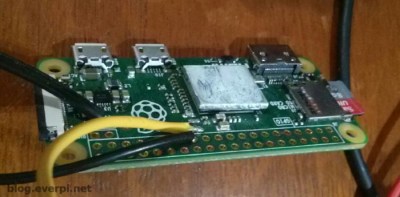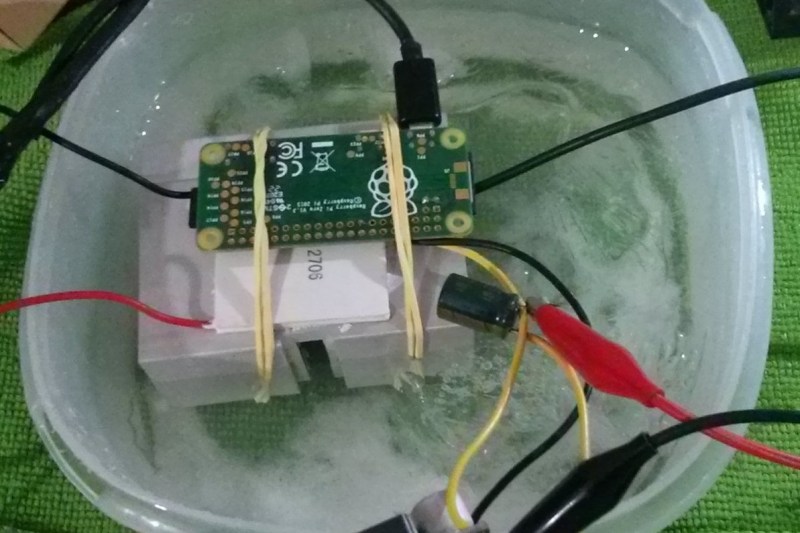[Alex Rissato] proudly reports that he now holds the record for highest benchmark score on HWBOT (machine translation); something he sees not only as a personal achievement but admirably, of national pride. Overclocking a Raspberry Pi is not as simple as achieving the highest operational clock rate. A record constitutes just the right combination of CPU clock, memory clock, GPU clock and finally the CPU core voltage. If you’ve managed to produce that special sauce, the combination must be satisfactorily cooled and most importantly be stable enough to pass an actual performance benchmark.

[Alex] realized that the main hurdle to achieving the desired CPU clock was the internally generated and hence restricted, CPU core voltage; This is externally LC filtered and routed back to the CPU on a stock Pi. [Alex] de-soldered the filter on the PCB and provided the CPU with an externally generated core voltage.
Next, the cooling had to be tended to. Air cooling simply wouldn’t cut it, so a Peltier based heatsink interface had to be devised with the hot side immersed in a bucket of salt water. All of this translated to a comfy 16C at a clock speed of 1600 MHz.
Was all the effort justified? We certainly think it was! Despite falling short of the Pi zero CPU clock rate record, currently set at 1620MHz, [Alex] earned the top spot in the HWBOT Prime overclocking benchmark. Brazil can now certainly add this to its trophy cabinet, arguably overshadowing the 129 Olympic medals.
















Now the Pi is emulating old consoles even faster :)
Why is cold side of the Peltier in the water? Doesn’t make sense. You want the cold side on the your CPU and hot side in the bucket.
It was a typo.
Fun fact: Peltier cooling will run in either direction you want. If you’ve actually installed it backwards, just reverse the polarity of the power you give it.
But saying “just reverse the polarity” sounds Star Trek-ish!
That was my fault. Must be a different way of thinking. I would call the part that touches the chip the “hot side” because you’re trying to remove heat and put it on the “cold side”. My brain must be backward :-D
Very cool…..
To obvious? I’ll get my coat. ;)
Did you know if you put a candle underneath a peltier unit it will generate electricity?
Are you related to George ?, Funny you should say that.
I’m new to this Peltier cooling business, but shouldn’t the hot side be immersed in water and the cold side be the CPU colling part?
Yes indeed, that was a typo. Fixed now! Thanks!!
I assumed from my headline lingo interpreter that Brazilians won.
I’ve always wondered exactly how much a brazilian was and now I know, 1,600,000,000
Urg. More running parts past their specs. Will you kids ever start to understand it is just bad engineering?
Be quiet.
You’re not supposed to tell them that they’re not doing engineering, and that they’re not engineers.
Dude they’re using Raspberry Pis, they were never engineers in the first place. Overclocking a pi is like simultaneously having down syndrome and an IQ of 115
It’s really good to know how to make the Raspberry Pi blink LEDs faster than it normally can.
For only $35.00, users can now get an NE 555 emulator,which blinks LEDs at a higher rate than the stock version; now if we could only get the Pi to do something else useful…
True that, You can get a pi, install an full-blown OS on it along with some RTL software and create/simulate/debug chips! Your choice if you only use it to do a 555 IC…
Does Pi/arduino have a corporate partnership with hack a day? Because there are three dipshit-board related articles in a row. It’s almost like they don’t want us to know how to solve problems through applied techniques honed over 100 of years. Make magazine did the same thing, it used to be about pirating tv and knives, now it’s a splooge rag for cucked, stay at home dads. Hell, both make and this place has been that wat since 2009. I grew up with both, and I miss actual projects/schematics/creative thinking on both LIKE A DEAD RELATIVE.
Counting as a personal achievement. ok. I honor that. But attaching national pride to it .. is a pain.
Why so much hate towards RPI and Arduino?